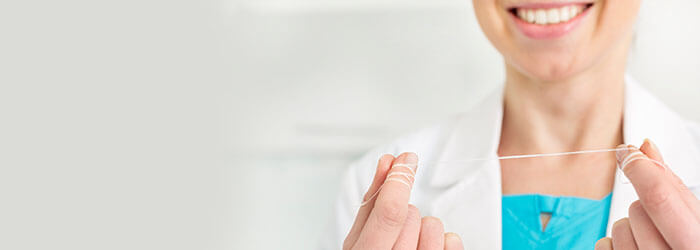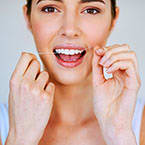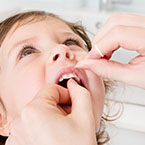HOW TO USE DENTAL FLOSS

- The Proper Flossing Technique
- Using a Flosser
- Using an Electric Flosser
- Flossing Around Dental Work
- Be Gentle
Gum disease begins at the gum line and between teeth. Daily flossing is an important part of your oral health care routine to help remove the plaque from these areas where a toothbrush doesn’t completely reach. But to truly reap the benefits, you need to use proper flossing technique.
The Proper Flossing Technique
You’re flossing. Great. But in order for dental floss to effectively remove plaque from your teeth, you need to be sure you’re using the correct technique.
Because you’ll be putting your fingers into your mouth, be sure to wash your hands before you reach for the floss. The American Dental Hygienists’ Association explains the key elements of proper flossing technique in four simple steps:
- Wind: Wind 18 inches of floss around either the middle finger or the index finger of one hand, whichever you prefer, and a small amount onto the middle or index finger of the other hand. (Using the middle finger leaves your index finger free to manipulate the floss.) That sounds like a lot, but you want enough to keep a clean segment in place as you move from tooth to tooth. Pinch floss between thumbs and index fingers, leaving a one- to two-inch length in between. Use thumbs to direct floss between upper teeth.
- Guide: Keep a one- to two-inch length of floss taut between fingers. Use index fingers to guide floss between contacts of the lower teeth.
- Glide: Gently guide floss between the teeth by using a zig-zag motion. Be careful not to let the floss snap or “pop” between teeth. Contour floss around the side of the tooth, making a C shape with the floss as you wrap it around the tooth.
- Slide: Slide floss up and down against the tooth surface and under the gum line, and don’t forget to floss the back side of each tooth. As you move from one tooth to the next, unroll a fresh section of floss from the finger of one hand while rolling the used floss onto the finger of the other hand. Use your thumb as a guide.
This technique applies to any type of floss: waxed, unwaxed, spongy floss or dental tape. As long as you use the correct technique, the type of floss you use is a matter of personal preference. There are many types to choose from, and you can even choose a variety of types to meet your needs and those of your family members.
It doesn’t matter whether you start with your upper or lower teeth, or whether you start in the front or the back. Just make sure that you floss all your teeth, including the back side of the very last tooth on the left, right, top and bottom of your mouth. And don’t forget to floss under the gum line and along the sides of teeth that border any spaces where teeth are missing—food particles can become trapped in these spaces, too. Using the correct technique will help you remove the excess food particles and plaque buildup between your teeth and help improve your oral health. Pair flossing with twice daily brushing as well—an electric toothbrush like the Oral-B iO can help remove more plaque from your gum line and in-between teeth as the round brush head and micro-vibrating bristles surround each tooth for a more thorough clean.
Popular Pairing with Flossing
549
Using a Flosser
If you use a hand-held flosser, the flossing technique is similar. Hold the flosser handle firmly and point the flossing tip at an angle facing the area you want to floss first (either top teeth or bottom teeth). Guide the floss gently between two teeth, and be sure to avoid snapping or popping the floss. Use the same zig-zag motion that you would use with standard floss. Bend the floss around each tooth and slide it under the gum line and along each tooth surface.
Using an Electric Flosser
The same basic flossing techniques apply if you choose an electric flosser. Guide the floss gently into place and move the flosser back and forth to create a zig-zag motion with the floss. Do you have trouble reaching the back sides of the back teeth? Some flossers have angled handles that make it easier to reach those tricky spots.
Flossing Around Dental Work
If you wear braces or other dental appliances, proper flossing technique is especially important to avoid getting floss caught on wires or brackets. You can use special orthodontic floss, which has a stiff end that can be easily threaded under the main wire (also called the arch wire) on your braces. Or you can purchase a floss threader, which is a flexible device with a pick on one end and a loop on the other. To use a floss threader, place an 18-inch piece of the floss of your choice through the loop. Then insert the pointed end of the flosser under the main wire and pull through so the floss is under the main wire. Once you have the floss in place, follow the same principles of proper flossing technique that you would use with standard floss.
Being Gentle
Poor flossing technique can result in complications, and it's important to be thorough yet gentle, especially when flossing with an electric flosser. Be sure you understand how to use it. You can always ask your dental professional to show you if you are uncertain.

069055128886|069055127520|069055857496




